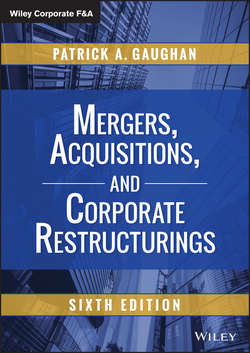Читать книгу Mergers, Acquisitions, and Corporate Restructurings - Gaughan Patrick А. - Страница 21
На сайте Литреса книга снята с продажи.
Part I
Background
Chapter 1
Introduction
Holding Companies
ОглавлениеRather than a merger or an acquisition, the acquiring company may choose to purchase only a portion of the target's stock and act as a holding company, which is a company that owns sufficient stock to have a controlling interest in the target. Holding companies trace their origins back to 1889, when the State of New Jersey became the first U.S. state to pass a law that allowed corporations to be formed for the express purpose of owning stock in other corporations. If an acquirer buys 100 % of the target, the company is known as a wholly owned subsidiary. However, it is not necessary to own all of a company's stock to exert control over it. In fact, even a 51 % interest may not be necessary to allow a buyer to control a target. For companies with a widely distributed equity base, effective working control can be established with as little as 10 % to 20 % of the outstanding common stock.
Advantages
Holding companies have certain advantages that may make this form of control transaction preferable to an outright acquisition:
● Lower cost. With a holding company structure, an acquirer may be able to attain control of a target for a much smaller investment than would be necessary in a 100 % stock acquisition. Obviously, a smaller number of shares to be purchased permits a lower total purchase price to be set. In addition, because fewer shares are demanded in the market, there is less upward price pressure on the firm's stock and the cost per share may be lower. The acquirer may attempt to minimize the upward price pressure by gradually buying shares over an extended period of time.
● No control premium. Because 51 % of the shares are not purchased, the full control premium that is normally associated with 51 % to 100 % stock acquisitions may not have to be paid.
● Control with fractional ownership. As noted, working control may be established with less than 51 % of the target company's shares. This may allow the controlling company to exert certain influence over the target in a manner that will further the controlling company's objectives.
● Approval not required. To the extent that it is allowable under federal and state laws, a holding company may simply purchase shares in a target without having to solicit the approval of the target company's shareholders. As discussed in Chapter 3, this has become more difficult to accomplish because various laws make it difficult for the holding company to achieve such control if serious shareholder opposition exists.
Disadvantages
Holding companies also have disadvantages that make this type of transaction attractive only under certain circumstances:
● Multiple taxation. The holding company structure adds another layer to the corporate structure. Normally, stockholder income is subject to double taxation. Income is taxed at the corporate level, and some of the remaining income may then be distributed to stockholders in the form of dividends. Stockholders are then taxed individually on this dividend income. Holding companies receive dividend income from a company that has already been taxed at the corporate level. This income may then be taxed at the holding company level before it is distributed to stockholders. This amounts to triple taxation of corporate income. However, if the holding company owns 80 % or more of a subsidiary's voting equity, the Internal Revenue Service allows filing of consolidated returns in which the dividends received from the parent company are not taxed. When the ownership interest is less than 80 %, returns cannot be consolidated, but between 70 % and 80 % of the dividends are not subject to taxation.
● Antitrust issues. A holding company combination may face some of the same antitrust concerns with which an outright acquisition is faced. If the regulatory authorities do find the holding company structure anticompetitive, however, it is comparatively easy to require the holding company to divest itself of its holdings in the target. Given the ease with which this can be accomplished, the regulatory authorities may be quicker to require this compared with a more integrated corporate structure.
● Lack of 100 % ownership. Although the fact that a holding company can be formed without a 100 % share purchase may be a source of cost savings, it leaves the holding company with other outside shareholders who will have some controlling influence in the company. This may lead to disagreements over the direction of the company.
